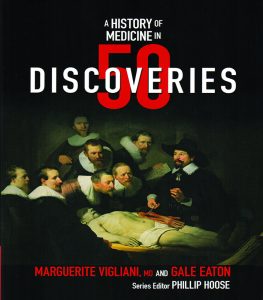Why are there so many tidy round holes in prehistoric skulls? Possible answers might include sword punctures, falling rocks, acid drips in tombs, or beetles and rodents gnawing at the skull after death. Paul Broca (1824-1880) had a different explanation: surgery, done on living patients. Even in the Stone Age, humans performed an operation called trepanation, drilling a hole in the patient’s skull.
Broca was a French doctor famous for work on the brain. He understood that different parts of the brain have different functions, and he developed a way of using landmarks on the skull to locate parts of the brain. When one of his patients had trouble talking after a closed head injury, Broca found the problem, trepanned the man’s cranium, and drained an underlying abscess. He reported the case in 1876; it was the first “neurosurgery based on the new theory of cortical localization of function.”
Since he was also a famous anthropologist, it was only natural that anyone who wanted a second opinion on a prehistoric skull would turn to Broca. George Squier (1821-1888) did just that to resolve controversy over a skull he’d acquired in Peru. Squier thought the hole in this skull was made by an ancient American surgeon during the patient’s life; members of the New York Academy of Medicine thought it was done after death. So in 1867, Squier asked Broca to examine the skull.
Broca concluded the operation had been done a week or two before the patient’s death; it had begun to heal. But why was it done? Squier thought it might have been a response to head trauma, but no visible cracks in the skull confirmed that idea. Had there been a closed head injury? Maybe the Incan surgeon had operated to relieve pressure, just as Broca himself would have done.
The Peruvian skull excited French anthropologists, and soon they were unearthing ancient skulls in France. Broca’s friend P. Barthélemy Prunières discovered many with large openings, and near them he found rondelles—round pieces of cranial bones, polished and shaped like amulets. Broca came to believe that Neolithic humans had practiced trepanation, largely on children, to cure some problem; he thought the rondelles were “tied to primitive religious beliefs.” Many researchers have accepted Broca’s ideas. If Neolithic humans thought seizures were caused by demons that escaped through the holes, maybe they also thought children who survived were sacred, and amulets made from their skulls had power. It’s a theory.
Since Broca’s time, anthropologists around the world have found hundreds of trepanned skulls. Some European examples are more than 10,000 years old, and North African ones are even older. Broca was right to think cranial surgery dates back to the Stone Age.

Hardcover, 288 pages; Tilbury House Publishers, 2017.
But was he right about why it was done? Answers may vary with culture. Some trepanations may have relieved pain or pressure in the head. In ancient Peru, Denmark, and China, it seems likely that warriors were trepanated after right-handed enemies bashed them on the left side of the skull. In today’s Kenya, the Gusii people remove fractured bone after head trauma.
Classical Greek and Roman writings recommended trepanation for head injuries with or without fracture, and we now regard putting holes in the head as the correct way to release a buildup of old blood or pus under the skull. Trepanation may have been humanity’s first surgical discovery.
And Paul Broca, investigating early examples of it, was pioneering a new area of medical research: paleopathology, or the study of ancient illnesses. Broca was a physician, an anatomist, and an anthropologist; today’s paleopathologists are trained in even more disciplines. Using research tools that range from DNA sequencing to CT scans on the remains of ancient humans, they find new answers to old questions.
- Old Chinese stories tell of the surgeon Hua Tuo (c. AD 140-c. 208), known as the Chinese “Father of Medicine.” Tuo was legendary for his ability to diagnose and cure all manner of ailments. His special anesthetic, Ma Fei San, was so powerful that patients could sleep through surgery and feel no pain; it was probably made of boiled cannabis dissolved in wine, though other traditional ingredients have been suggested.
According to legend, the Emperor Cao Cao was struck by unbearable headaches and called on Tuo for help. Tuo said the headaches were caused by the pressure of air and fluid building up inside the skull. To relieve the pain, he would have to anesthetize the emperor and open his skull. But Cao Cao, fearing assassination, had Tuo executed.
His medical secrets did not survive him. Tuo had a book—by some accounts, he received it from mysterious old men, clearly immortals, in a cave that collapsed right after he left it. Whether he relied on their magical secrets alone or added to the book from his own observations and experience, it was a valuable thing, and he left it to his kind jailer. But the jailer’s wife burned it; being a great doctor was all too likely to get a man executed.

![Discovering Ancient Skull Surgeries HOLE IN THE HEAD: This girl's skill was trephinated [trepanned] in 3500 BC. She survived.](https://medicine.at.brown.edu/wp-content/uploads/2017/10/50Discoveries.Opener.jpg)


